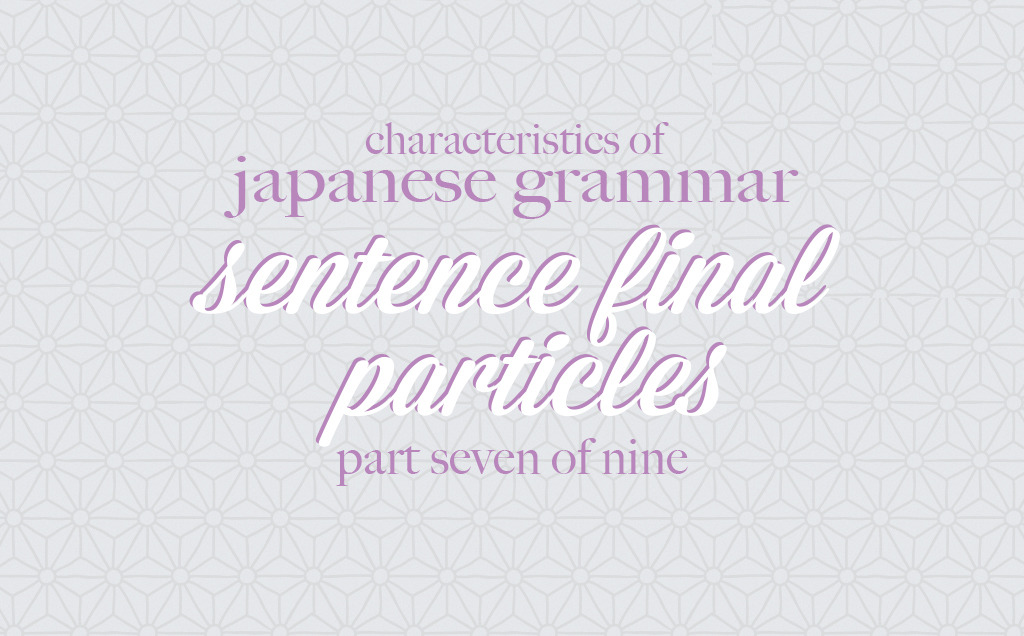atejapan: PREFACE: This is a nine part series of some important things to keep in mind while studyin
atejapan: PREFACE: This is a nine part series of some important things to keep in mind while studying Japanese grammar. It’s very different from English, so try not to study it through an “English lens.” To understand grammar points better, it’s really beneficial to learn the characteristics behind Japanese grammar. These notes are taken from A Dictionary of Japanese Grammar. To see the other parts, click here. PS: I’ve decided to skip part 6 (politeness and formality). 7. Sentence Final Particles Placed at the end of a main clause, sentence final particles indicate the function of the sentence or expresses the speaker’s emotions. Some are used exclusively by male or female so these particles can also express masculinity or femininity. か: makes the sentence a question 山田さんは先生ですか。やまださんはせんせいですか。 Is Yamada is a teacher? ね: used to ask for confirmation or to soften requests/invitations 山田さんは先生ですね。やまださんはせんせいですね。 Yamada is a teacher, isn’t he? 一緒に行きましょうね。いっしょにいきましょうね。 Let’s go together, shall we? な: used as the negative imperative marker when used with informal nonpast verbs; sometimes used like ね when used with informal declarative/invitational sentences (this function is only used with men) こっちへ来るな。こっちへくるな。 Don’t come this way. 一緒に行こうな。いしょにいこうな。 Let’s go together, shall we? よ/ぞ/ぜ: used for assertion (”you know” “believe me” “I’d say”); ぞ and ぜ are exclusively for males; よ and ぜ can be used in invitational sentences 私は知りませんよ。わたしはしりませんよ。 I don’t know, believe me. おれは負けないぞ。おれはまけないぞ。 I won’t lose! 今晩は飲もうよ。/今晩は飲もうぜ。 こんばんはのもうよ。/こんばんはのもうぜ。 Let’s drink tonight! わ: used in declarative sentences to give a feminine flavor and sometimes express a light assertion (used in both formal and informal speech); can be used with ね and よ but not か 私はまだ十八ですわ。わたしはまだじゅうはちですわ。 I’m still eighteen. 私も行くわよ。わたしもいくわよ。 I’m going too. ね/な/わ: used in exclamatory sentences; ね can convey the idea of confirmation; な is usually used by men but can be used in conversation by young women; わ is used only by women きれいだねえ。(male) きれいだわねえ。(female) Isn’t it pretty! かい/だい: かい is used to mark yes/no questions and だい is used to who/what/when/where/why/how questions; both used in informal male speech これは君の本かい。これはきみのほんかい。 Is this your book? これはだれの本だい。これはだれのほんだい。 Whose book is this? の: replaces んですか/のですか; used in informal female speech as a question marker パーティーに行かないの? パーティーにいかないの? Aren’t you going to the party? かしら/かなあ: expresses speaker’s uncertainty about a proposition; かしら used by females and かなあ used by males あしたは雨かしら。(female) あしたは雨かなあ。(male) あしたはあめかしら。あしたはあめかなあ。 Will it rain tomorrow, I wonder? -- source link
Tumblr Blog : atejapan.tumblr.com
#nihongo#japanese language#japanese grammar#日本語
